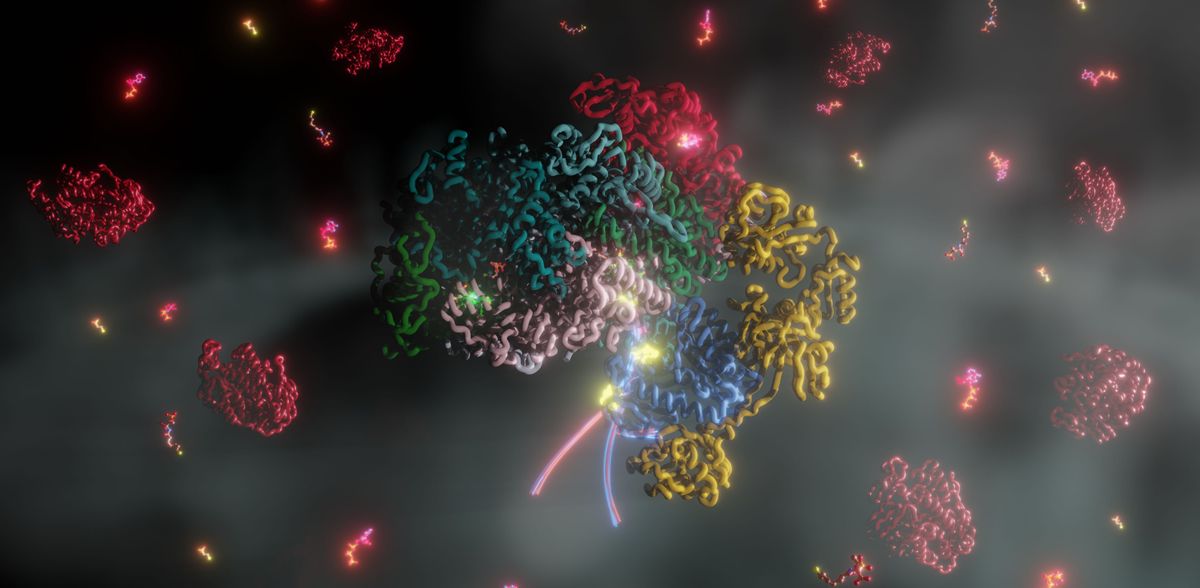Breakthrough in methane research: Activation mechanism of methane-producing enzyme decoded
"Nature" publication reveals the evolutionary link between two fundamental biological processes
Researchers at the Center for Synthetic Microbiology (SYNMIKRO) at Philipps-Universität Marburg and TU Berlin have made a major breakthrough in understanding the activation of methyl-coenzyme M reductase (MCR) - the enzyme responsible for almost all biological methane production and one of the most abundant enzymes on Earth. Their results have now been published in "Nature" and not only shed new light on one of the oldest processes of energy production in nature, but also reveal an unexpected evolutionary link to so-called nitrogen fixation.
In this first step of the global nitrogen cycle, microorganisms absorb nitrogen from the air and convert it so that living organisms can utilize it. "Basic research in the field of biological energy and material conversion holds considerable potential for tackling current challenges such as mankind's constantly growing energy needs and the advancing climate change," explains Dr. Christian Lorent, co-author of the "Nature" publication and research associate at the Cluster of Excellence Unifying Systems in Catalysis (UniSysCat), which is based at TU Berlin.
The two sides of the greenhouse gas
Methanogenic archaea are microorganisms that have existed for billions of years and produce up to one billion tons of methane annually, for example in the stomachs of ruminants or in wetlands. Although methane is a potent greenhouse gas that contributes to global warming, biological methane production also holds great potential as a renewable energy source through the production of biogas in agriculture. A deeper understanding of the basic mechanisms of methane formation can lead to advances in sustainable energy technologies and climate protection.
One of the most challenging redox reactions
At the heart of biological methane production is MCR, a highly specialized enzyme whose active site contains the unique coenzyme F430. The function of this cofactor depends crucially on a central nickel ion, which must be in the oxidation state Ni(1+) to catalyze methane production. However, the activation of nickel to this state requires overcoming a considerable energetic hurdle - one of the most challenging redox reactions in nature. How early life forms managed this activation has long been unclear.
In their study, the research team succeeded in isolating and characterizing the MCR activation complex from the model organism Methanococcus maripaludis. "We found that a small protein called McrC, together with other methanogenic marker proteins, activates the MCR in an ATP-dependent process and thus provides the necessary energy for methane production," explains Fidel Ramírez-Amador from the Philipps University of Marburg, one of the lead authors of the study.
Spectroscopic investigations provided the missing proof
Remarkably, the researchers were able to show that the activation mechanism requires three uniquely structured and highly specialized metal complexes that were previously only known in nitrogenase, the only enzyme that can convert atmospheric nitrogen into biologically available forms. "The spectroscopic investigations provided the missing evidence that these cofactors consist of iron and sulphur and are probably crucial for electron transfer," explains Dr. Christian Lorent. Dr. Jan Schuller from the Philipps University of Marburg, senior author of the study, adds: "This striking similarity suggests that these systems have a common evolutionary origin despite having completely different functions. Our study establishes an unprecedented evolutionary link between two fundamental biological processes: methanogenesis and nitrogen fixation."
"The most elegant solutions for energy production and the most efficient catalysts have been evolutionarily optimized in nature over millions of years. It is our job as scientists to find, understand and apply them," summarizes Dr. Christian Lorent. In the UniSysCat Cluster of Excellence, he is researching the reaction mechanisms and coupling of various metalloenzymes, which can also produce hydrogen or bind the greenhouse gas carbon dioxide, for example.
Note: This article has been translated using a computer system without human intervention. LUMITOS offers these automatic translations to present a wider range of current news. Since this article has been translated with automatic translation, it is possible that it contains errors in vocabulary, syntax or grammar. The original article in German can be found here.
Original publication
Fidel Ramírez-Amador, Sophia Paul, Anuj Kumar, Christian Lorent, Sebastian Keller, Stefan Bohn, Thinh Nguyen, Stefano Lometto, Dennis Vlegels, Jörg Kahnt, Darja Deobald, Frank Abendroth, Olalla Vázquez, Georg Hochberg, Silvan Scheller, Sven T. Stripp, Jan Michael Schuller; "Structure of the ATP-driven methyl-coenzyme M reductase activation complex"; Nature, 2025-4-16



















































